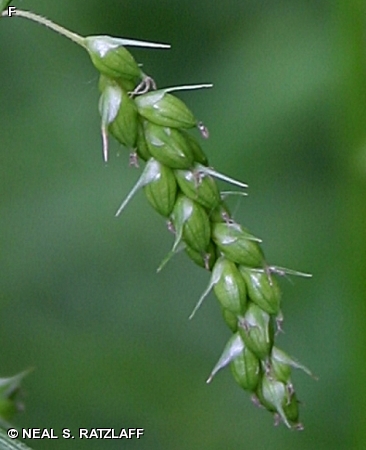
This attractive bunched sedge has flowering stems from 12-36 inches tall which may be shorter or longer than the prominent grass-like leaves. The distinctive upper spike has male flowers below, but the upper portion is female (A,C). Below this bisexual spike are 2-3 female spikes which are erect when young (C), but usually nod or droop when mature (D,E). The perigynia have scales with prominent awns at their tip (F). Perigynia, initially a light green, turn yellow-brown or a striking orange color as they mature (G,H).
Moist woodlands. Although found in the uplands, it is significantly more common in floodplain woods at both Fontenelle Forest and Neale Woods. In Fontenelle Forest it is quite common along Gifford Memorial boardwalk and Cottonwood Trails. There are a few plants along Ridge Trail in the uplands. At Neale Woods it is harder to find. The best spot is Missouri River Ecology Trail where it is uncommon. Flowering occurs in early to mid-May. The green perigynia appear at that time (C) maturing during May and turning yellow-brown or orange by mid to late June (G).
A few of our sedges at FF/NW with predominantly unisexual spikes may have a bisexual upper spike with males at the tip and females below, but none have a bisexual upper spike with female flowers at the tip like that of Carex davisii.
The content of NatureSearch is provided by dedicated volunteer Naturalists of Fontenelle Forest who strive to provide the most accurate information available. Contributors of the images retain their copyrights. The point of contact for this page is: Neal Ratzlaff.







